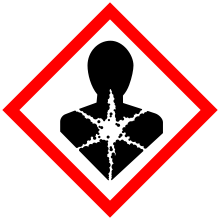Teratogen

Ateratogenis a material that can causebirth defects.Teratogens include somechemicals,medications,andinfectious diseases.The name goes back to Ancient Greek "theras", which can be translated as "monster".
About 75% of all birth defects are caused by teratogens.[1][2]p. 23-3
Types of teratogens
[change|change source]Alcohol and illegal drugs
[change|change source]Alcoholis the most common cause of congenital disorders that can be prevented.[3]Alcohol ispoisonousto afetusand can causebrain damage.[4]Drinking alcoholwhilepregnantcan cause the fetus to getfetal alcohol syndrome.[3]
Illegal drugs,likeheroinandcocaine,are also poisonous to the fetus and can cause many different congenital problems. For example, cocaine use during pregnancy can causemicrocephaly(a smaller head size than usual) and problems with the way the fetus'surinary systemandgenitalsgrow.[1]
Medications
[change|change source]
Some medications can also hurt the fetus if its mother takes them while she is pregnant. For example:[1][2]p. 23-6
- Lithium carbonate(used to treatbipolar disorder) can cause problems in the way the fetus'sheartgrows
- Phenytoinandvalproic acid(anti-seizure medications) can causeintellectual disability,microcephaly, and many other problems in fetuses
- Warfarin(a blood-thinning medication) can cause problems with the fetus'scentral nervous system,including intellectual disability
- ACE inhibitors(a group of medications forhigh blood pressure) can cause problems with the fetus'skidneys
Before the 1960s, many countries did not have rules about testing medications for their effects on fetuses.[5]This changed partly because ofthalidomide.This medication was given to pregnant women fornauseain the 1950s and 1960s. Between 1956 and 1962, more than 10,000 children in 46 different countries were born with birth defects, like arms and legs that had not grown.[6]Thalidomide had not been tested well enough before it started beingprescribed.[6]Now, many countries require more testing before a medication can be said to be safe during pregnancy.[5]
Infections
[change|change source]
If a woman gets an infection while she is pregnant, sometimes the infection can affect her fetus. Theplacentaprotects the fetus from many differentviruses,bacteria,and otherpathogensthat cause infections. However, some pathogens can get through the placenta and infect the fetus. This is calledvertical transmission.Some of these infections can cause birth defects.
Examples of infections that can cause birth defects include:
- Syphilis[7]
- Toxoplasmosis[8]
- Chickenpox[9]
- Rubella(German measles)[10]
Chemicals
[change|change source]Some chemicals can cause birth defects, if a pregnant woman isexposedto enough of them. For example:[11]
- Lead:If a woman ever hadlead poisoning,she can pass lead on to her fetus, even if she is not exposed to lead while she is pregnant. This happens because most lead is stored in a person'sbonesand can come out into thebloodstreammany years later. Lead can causemiscarriageandstillbirthas well as birth defects.
- Mercury:High levels of mercury can causebrain damagein fetuses.
Other things
[change|change source]High levels ofionizing radiationcan cause birth defects.[2]p. 23-8
Things that are not teratogens
[change|change source]Examples of things that do not cause birth defects include:[11]
- Spermicides(these were suspected of causing birth defects in the 1970s and 1980s, but they have been proven to be safe)
- Acetaminophen(paracetamol)
- Prenatal vitamins
- Non-ionizing radiation. This is the type of radiation that comes fromsunlightandmicrowave ovens.It does not cause birth defects.
References
[change|change source]- ↑1.01.11.2"Things to Avoid During Pregnancy: Teratogens".AboutKidsHealth.The Hospital for Sick Children.RetrievedFebruary 17,2016.[permanent dead link]
- ↑2.02.12.2Chung, Wendy (2004). "Teratogens and Their Effects".The New Public Health: An Introduction for the 21st Century.New York: Columbia University Press.ISBN978-0127033501.
- ↑3.03.1"Facts about FASDs".cdc.gov.United States Centers for Disease Control and Prevention(CDC). April 16, 2015.RetrievedFebruary 14,2016.
- ↑"Fetal Alcohol Syndrome".ncbi.nlm.nih.gov.United States National Library of Medicine.RetrievedDecember 28,2015.
- ↑5.05.1Tantibanchachai, Chanapa (January 22, 2014)."Teratogens".The Embryo Project Encyclopedia.Arizona State University.ISSN1940-5030.RetrievedFebruary 14,2016.
- ↑6.06.1Bren L (February 28, 2001)."Frances Oldham Kelsey: FDA Medical Reviewer Leaves Her Mark on History".FDA Consumer.U.S.Food and Drug Administration.RetrievedFebruary 14,2016.
- ↑"STDs during Pregnancy – CDC Fact Sheet".CDC.gov.United States Centers for Disease Control and Prevention. February 3, 2016.RetrievedFebruary 9,2016.
- ↑Torgerson, Paul R; Mastroiacovo, Pierpaolo (2013-07-01)."The global burden of congenital toxoplasmosis: a systematic review"(PDF).Bulletin of the World Health Organization.91(7): 501–508.doi:10.2471/BLT.12.111732.ISSN0042-9686.PMC3699792.PMID23825877.
- ↑Boussault, Pierre; Boralevi, Franck; Labbe, Laurence; Sarlangue, Jean; Taïeb, Alain; Leaute-Labreze, Christine (July 2007)."Chronic Varicella-Zoster Skin Infection Complicating the Congenital Varicella Syndrome".Pediatric Dermatology.24(4): 429–432.doi:10.1111/j.1525-1470.2007.00471.x.ISSN0736-8046.PMID17845179.S2CID22389596.
- ↑"Congenital Rubella Syndrome - Vaccine Preventable Diseases Surveillance Manual | CDC".www.cdc.gov.2022-04-06.Retrieved2022-04-09.
- ↑11.011.1Gilbert-Barness E 2010 (20 March 2010)."Teratogenic Causes of Malformations".Annals of Clinical & Laboratory Science.40(2). Association of Clinical Scientists, Inc.: 99–114.PMID20421621.RetrievedFebruary 2,2016.
{{cite journal}}:CS1 maint: numeric names: authors list (link)
